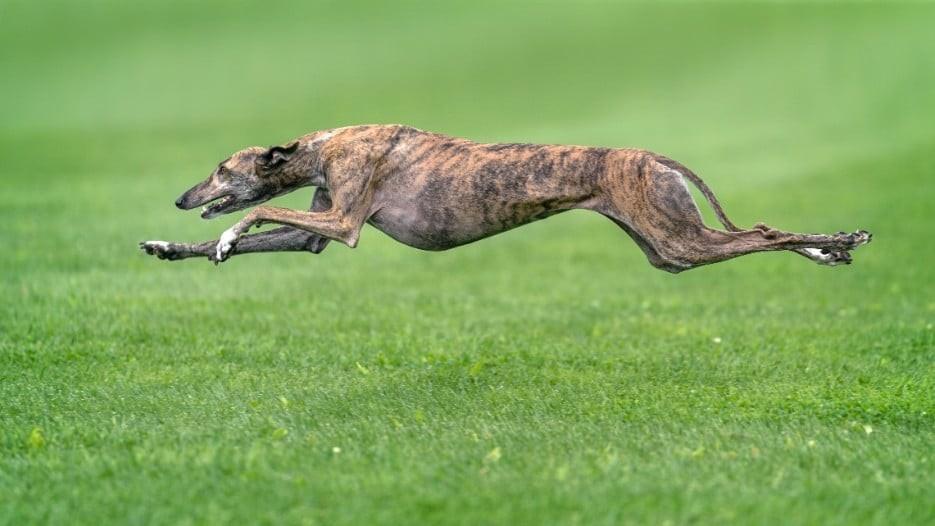
Greyhound
A hunting and racing kind of a dog breed, Greyhounds are loving and cuddly family dogs.
Breed Profile
Height
28 – 30
Inches
Weight
60 – 90
Pounds
Life Span
10 – 14
Years
Health
health
Twisted Gut or Gastric-Dilatation-Volvulus
What is it?:
Because of their big stomachs and deep chests, Greyhounds are usually prone to gastric and bloating problems which is referred as ‘Twisted Gut’ by the breeders. It is also called as gastric-dilatation-volvulus or GDV. Here, air gets filled in the stomach which prevents the blood from the stomach to return to the heart
Clinical signs
Swollen abdomen
Reverse movement of the stomach or the esophagus
Painful and loud whining
Abnormal drooling or salivation
Restlessness
Pain if pressed at the abdomen
Treatment
Treatment may include surgery
Eligible vet bill
$3,500
*Hypothetical reimbursement examples illustrate reimbursement of an eligible vet bill at the noted reimbursement rate, assuming the annual deductible had already been satisfied and the annual coverage limit has not yet been met. Annual deductible, co-insurance, benefit and coverage limits, and exclusions may apply. Eligibility may vary. Visit https://spotpet.com/sample-policy for full terms. For Canada enrollments only, reimbursement rate is based on the pet's age.
health
Esophageal Achalasia
What is it?:
The term ‘achalasia’ refers to the emptying of the esophagus which is the cardinal feature of this disorder. This can lead to inability to swallow foods or liquids.
Clinical signs
Weight loss
Loss of appetite
Pain in the chest when pressed or held
Refusing to swallow
Treatment
A laparoscopic Heller myotomy may be the appropriate primary treatment of patients with achalasia.
Eligible vet bill
$3,000
*Hypothetical reimbursement examples illustrate reimbursement of an eligible vet bill at the noted reimbursement rate, assuming the annual deductible had already been satisfied and the annual coverage limit has not yet been met. Annual deductible, co-insurance, benefit and coverage limits, and exclusions may apply. Eligibility may vary. Visit https://spotpet.com/sample-policy for full terms. For Canada enrollments only, reimbursement rate is based on the pet's age.
Personality
Fast
These tall dogs with strong legs are often referred to as the Ferrari’s of the dog world as they can attain a high speed of 70 km/hr
Sensitive
The hounds are very weather sensitive and cannot survive properly in very cold weathers
Affectionate
They are a very loving breed and a great family dog. Good with kids as well as older or differently abled people
Lifetime Care
Coat
Greyhounds carry a single, short coat with loose hair which has a little tendency of shedding
Colors
Despite the name the breed is actually seen in 30 different shades including white, brindle, fawn, black, red, and blue
Hypoallergenic
No
Grooming
Because of their slightly shedding nature, they require a daily brush with a soft bristly brush. Apart from that regular dental, ear and teeth cleaning sessions would be recommended.
Training
Even a first time dog owner can easily train a Greyhound given their intelligence to quickly pick up basic commands. Although, they can be reluctant at times.
Learn more about the cost of caring for a Greyhound.
The Greyhound breed can be dated as back as 4000 years ago where its remains were found in modern day Syria. So, all modern Greyhounds are the offspring of the sighthounds which were primarily used for hunting, coursing and racing. Surprisingly, the Greyhounds also find a mention in the Bible in a few versions. Apparently the word ‘Greyhound’ does not actually mean a grey hunting dog but ‘a fair dog.’
Greyhound Dog: Introduction to the Breed
The breed makes excellent family dogs due to their love and affection side. However, it is always better to do know as much as possible about a breed before bringing them home.
Greyhound Dogs are generally:
Gentle and quiet
Non-aggressive
Laid back
Fast. Real fast.
Playful and cuddly
Greyhounds are best suited for –
First time dog owners
City apartment type setting household
People actually involved with dog racing
Families with kids and other pets (Not small pets like rabbits or hamsters)
Health Risks for a Greyhound Puppy
Apart from the above-mentioned common health problems, these racing dogs are also prone to some other health related issues which can give the owner a hard time to their time, head and even wallet.
Greyhounds are very sensitive to insecticides. It is advised to use only vet recommended fleas and ticks controllers
About 26% of these dogs are susceptible to delayed hemorrhage, a condition where the blood escaping from the circulatory system from damaged blood vessels.
They do not have any undercoats and hence are lacking body fat which can cover them up in cold weathers.
Things to watch-out before deciding to own a Greyhound
There are a few cautions that you need to know before deciding to adopt a Greyhound puppy
They might be the fastest dog breeds out there but on the other side they are big couch potatoes. This is where they get the name ‘40mph couch potato’
They are not suitable for houses with smaller pets like rabbits or hamsters as these hounds have big chasing instincts
If you are looking for a very very active dog, then the Greyhound might not be for you as they will happily sleep all day on your couch
They don’t make good watch dogs. They can be intimidating because of their size but are not very aggressive towards people
One of the most problematic behaviors in these dogs are fear, anxiety and uncertainty of unfamiliar environments
Not very great at training given their lazy nature at times, greyhounds will often find ways to escape training classes (Just like we did when we were kids)
Conclusion
If you’re going to get a Greyhound home, you’ll be bringing an irony home in the form of the fastest-lazy dog. But on the other hand, it will be perfect for the family with its gentle, loving and affectionate behavior.
Sources:


